The Tower of London.
Professor Richard Oram.
At the end of March 1406, the twelve-year-old James was brought to London by his Ipswich captors and handed over to King Henry IV. Child though he was, James was a rich prize for the English king and needed to be kept safe and secure until the best way to capitalise on his capture could be determined. The safest place to hold him was in the Tower of London, where he was close to hand should his physical presence be needed in negotiations with his father in Scotland, but where he could be kept in close but comfortable confinement. When news came of Robert III’s death, the value of the now King James increased greatly, as did the need to keep him in secure surroundings.
Although we see the Tower of London primarily as a fortress-prison, made infamous by the flow of ‘traitors’ through its gates to their show-piece executions in the Tudor Age and later, it was also a well-appointed royal palace. James was not kept in chains in some dank dungeon but was given a comfortable chamber in the upper level of the White Tower itself, or in one of the towers in the circuit of walls which enclosed it. There, he could be kept under careful watch while still being able to keep his own small group of servants and to receive visitors from Scotland.
James did not spend all eighteen years of his captivity in the Tower. He was moved around several other English royal castles, from Pevensey on the Sussex coast to Kenilworth and Nottingham in the Midlands, but most often moving between London and Windsor. During periods of greater tension with the Scots or political uncertainty in England, he was returned to the Tower. It was there that he met Charles, duke of Orléans, grandson of the French king Charles V, who had been taken prisoner at the Battle of Agincourt in 1415 and who spent twenty-five years in captivity. Charles, unlike James, spent almost that entire time in the Tower and it was there that he started to write the books of poetry for which he became famous. It is tempting to think that the two men, who were exact contemporaries, shared their poetry and that Charles’s often melancholy poems about imprisonment, like En la forêt de longue attente (in the forest of long waiting), inspired James’s musing on his captivity in The Kingis Quair.

